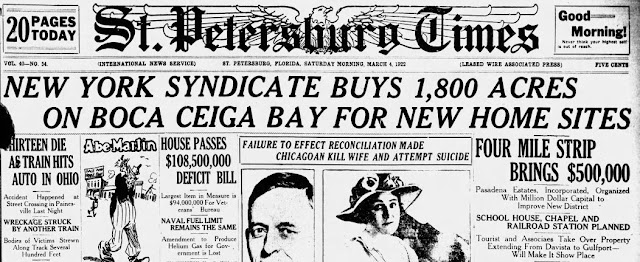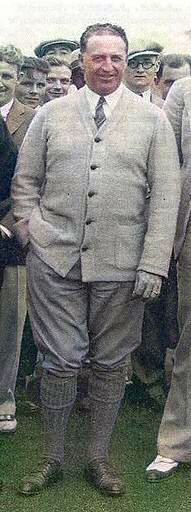Handsome Jack Taylor's Positive Impact
Pasadena-on-the-Gulf developer "Handsome Jack" Taylor's positive impact on St. Petersburg and the Jungle neighborhood is not fully appreciated by local historians who tend to view him as a con man (which is true), eager to make a quick buck and then get out of town. But without his involvement, it is questionable whether the Jungle Prado building (later called the Jungle Prada building), Jungle Country Club Hotel and scores of attractive homes would have been built in the Jungle and Pasadena neighborhoods. The building boom of the Roaring Twenties might have passed us by.
In March 1922, Taylor made a big investment that funded much of Walter P. Fuller's developments that began shortly thereafter. Taylor brought money, enthusiasm, planning, charisma and a work ethic to St. Petersburg and especially to Pasadena-on-the-Gulf. His successes and capital investment influenced Walter P. Fuller and his partners to move forward aggressively and build the Jungle Hotel, Piper-Fuller Airfield and Jungle Prada building, and also inspired many of the grand homes in the neighborhood.
The fact that there was a Roaring Twenties history in the Jungle was dependent on a long line of optimistic and determined men. Most of them were from the north. From Philadelphia came Hamilton Disston, Jacob Disston, F.A. Davis, George C. Allen and John Allen. Al Lang was from Pittsburgh, Jack Taylor from New York City.
Taylor Syndicate Buys 1800 Acres South of the Jungle
Taylor bought 1800 acres (2.81 square miles) of land south of the Jungle in 1922 and renamed the area Pasadena-on-the-Gulf. The territory included Davista and the west side of Gulfport.
Taylor had a shady background. As an investment banker, he had profited from dishonest stock market deals. He was a Yankee from New York City, while the other four St. Petersburg land boom giants (C. Perry Snell, Charles R. Hall, Walter P . Fuller, and N.J. Upham) all lived in St. Petersburg. Taylor burst onto the St. Petersburg real estate scene with marketing skills and enthusiasm that were foreign to the other land boom giants who were striving to match the successful developers in south Florida.
1920's Florida Land Boom
The 1920's Florida land boom began in Miami when Carl Graham Fisher built the Flamingo Hotel and began a national advertising campaign promoting Miami Beach real estate. In 1921, property developer George Merrick created the planned community of Coral Gables, west of Miami, and began promoting and selling lots. Land values began to rise and other communities sprang up in southern Florida.
 |
| Postcard: The Venetian Pool at Coral Gables |
In St. Petersburg, real estate values increased slowly between the end of World War I until the winter of 1922-23. Already trailing south Florida in the land boom, the 1921 Tampa Bay hurricane tempered enthusiasm for local properties.
Historians agree that the boom in St. Petersburg started in 1923 in the neighborhood near the foot of the new Gandy Bridge. Suddenly the real estate market surged and continued a wild run until 1926. During the boom, many beautiful buildings and homes were built in St. Petersburg, including the Jungle Hotel (1926) and the Jungle Prada building (1924).
From 1923 to 1926, land values rose precipitously in St. Petersburg. Most of the buyers were from northern states, many of them never visited the land they bought ‒ their purchases were handled by mail or through agents. With rapidly rising property values, a parcel of land could be bought and sold for a profit, sometimes multiple times in the same day.
Taylor Wanted a Piece of the Land Boom Action
Early in 1922, "Handsome Jack" Taylor saw the trend in Florida. He said he was married to a Du Pont heiress (which was not true) and he was a partner in the Taylor Syndicate, a New York investment firm with a dubious reputation. St. Petersburg land values were rising but the city was still recovering from the 1921 hurricane, so the boom had not started. Taylor found land along Boca Ciega Bay in Davista and Gulfport ‒ just south of the Jungle ‒ some of which had already been mapped by a professional city planner in 1916 when H. Walter Fuller owned the land. The Taylor Syndicate purchased 1,800 acres (2.81 square miles) in March, 1922.
click on image to enlarge
 |
| Pasadena-on the-Gulf (north section) Pinellas county Plat book 4, Page 60 (officialrecords.mypinellasclerk.org) |
Background
In 1914, H. Walter Fuller had big plans for developing his land in the Jungle and Davista, but the war economy ravaged his businesses and by 1917 he and his companies were insolvent. Rather than go into bankruptcy, Fuller assigned all his assets to a committee of bankers in Philadelphia.
In 1919, George C. Allen, a member of the committee, negotiated an arrangement advancing one million dollars to H. Walter Fuller and his son, Walter P. Fuller, to re-acquire the old Fuller companies on a partnership basis.
The post-war economy was picking up steam and before long each of the three partners prospered and the Fullers were able to pay back the advance. But by 1922, the partners found themselves with too much unsold land ‒ many of their properties were facing tax lien foreclosure. The $500K deal with the Taylor Syndicate resolved the deficit and provided the partners with working capital.
The very next year, the Allen-Fuller Corporation was formed. It was capitalized with money from the sale of the Davista and west Gulfport land. The Allen-Fuller Corporation would go on to purchase the Jungle Golf course from private investors and build the Jungle Prada building and Jungle Country Club Hotel.
Pasadena-on-the-Gulf
Taylor announced that he would rename his community Pasadena-on-the-Gulf. There would be a golf course, school, railroad station, chapel, elaborate homes, and well-paved streets and parkways. As Jack Taylor later described it, "an aristocratic resort community." |
-- St. Petersburg Times September 25, 1927
By the end of 1922, Taylor was advertising lots for sale in his premier community. Next, he landed the world's foremost professional golfer ‒ Walter Hagen ‒ to be president of his new Pasadena-on-the-Gulf country club. Taylor began building roads and homes and beautifying the community. There was a grand hotel, an aviary and a plant nursery. Walter Hagen worked on designing the golf course which included canals for canoe spectators and an island full of monkeys.
 |
| Jack Taylor's opulent home at 640 Villa Grande Ave S is still standing. |
All of that is true. But in 1922, Taylor's Pasadena-on-the Gulf venture was on the leading edge of a St. Petersburg land and building boom that no one thought would end. Jack Taylor left an indelible mark on the west coast of St. Petersburg. His 1922 land purchase inspired the grand buildings and homes that make our Jungle neighborhoods distinctive.
1925 Editorial: Jack Taylor Has Done the City Inestimable Good
The opening of the magnificent new offices in the Taylor arcade recalls the wonderful progress Pasadena has made in the last four years. In that short period Jack Taylor, president of Pasadena Estates. has built a new community within the city limits of St. Petersburg—a community with miles of paved and parked streets, scores of costly homes, two hotels, a golf course and clubhouse, and one of the largest nurseries in the South. Not only has Mr. Taylor made Pasadena, but in so doing he has hastened the development of the entire western section of St. Petersburg and through his confidence in the future has done the city inestimable good.
‒ St. Petersburg Times, Dec 11, 1925.
Addendum: Matt of Old Pasadena forwarded this article from the March 20, 1928 St. Petersburg Times. St. Petersburg historians assert that Jack Taylor left town abruptly in 1926, never to return, but here is evidence that he was still considered a "congenial dinner host" in 1928 at a banquet at the hotel that he built:


















